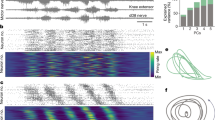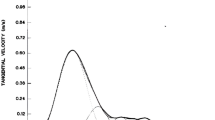Abstract
Recent experiments in the spinalized frog (Bizzi et al. 1991) have shown that focal microstimulation of a site in the premotor layers in the lumbar grey matter of the spinal cord results in a field of forces acting on the frog's ankle and converging to a single equilibrium position. These experiments suggested that the neural circuits in the spinal cord are organized in a set of control modules that “store” a few limb postures in the form of convergent force fields acting on the limb's end-point. Here, we investigate how such postural modules can be combined by the central nervous system for generating and representing a wider repertoire of control patterns. Our work is related to some recent investigations by Poggio and Girosi (1990a, b) who have proposed to represent the task of learning scalar maps as a problem of surface approximation. Consistent both with this view and with our experimental findings in the spinal frog, we regard the issue of generating motor repertoires as a problem of vector-field approximation. To this end, we characterize the output of a control module as a “basis field” (Mussa-Ivaldi 1992), that is as the vectorial equivalent of a basis function. Our theoretical findings indicate that by combining basis fields, the central nervous system may achieve a number of goals such as (1) the generation of a wide repertoire of control patterns and (2) the representation of these control patterns with a set of coefficients that are invariant under coordinate transformations.
Similar content being viewed by others
References
Bizzi E, Accornero N, Chappie W, Hogan N (1984) Posture control and trajectory formation during arm movement. J Neuorsci 4:2738–2744
Bizzi E, Mussa-Ivaldi FA, Giszter SF (1991) Computations underlying the execution of movement: A biological perspective. Science 253:287–291
Colgate E, Hogan N (1989) An analysis of contact instability in terms of passive physical equivalents. IEEE Proc Int Conf Robot Automat:404–409
Colgate E (1988) The control of dynamically interacting systems. PhD thesis, M. I. T. Department of Mechanical Engineering
Feldman AG (1966) Functional tuning of the nervous system during control of movement or maintenance of a steady posture. II. Controllable parameters of the muscles. III. Mechanographic analysis of the execution by man of the simplest motor task. Biophysics 11:565–578, 766–775
Giszter SF, Mussa-Ivaldi FA, Bizzi E (1991) Equilibrium-point mechanisms in the spinal frog. In: Arbib MA, Ewert JP (eds) Visual structures and integrated functions. Springer, Berlin Heidelberg New York, pp 223–237
Hogan N (1984) An organizing principle for a class of voluntary movements. J Neurosci 4:2745–2754
Kathib O (1986) Real-time obstacle avoidance for manipulators and mobile robots. Int Robot Res 5:90–99
Lozano-Perez T (1982) Task planning. In: Brady M, Hollerbach JM, Johnson TL, Lozano-Perez T, Mason MT (eds) Robot motion: planning and control. MIT Press, Cambridge
Mussa-Ivaldi FA (1992) From basis functions to basis fields: Using vector primitives to capture vector patterns. Biol Cybern 67:479–489
Mussa-Ivaldi FA, Hogan N (1991) Integrable solutions of kinematic redundancy via impedance control. Int J Robot Res 10:481–491
Mussa-Ivaldi FA, Hogan N, Bizzi E (1985) Neural, mechanical and geometrical factors subserving arm posture in humans. J Neuorsci 5: 2732–2743
Mussa-Ivaldi FA, Giszter SF, Bizzi E (1990) Motor-space coding in the central nervous system. Cold Spring Harbor Symp Quant Biol The Brain 55:827–835
Poggio T (1990) A theory of how the brain might work. Cold Spring Harbor Symp Quant Biol The Brain 55:899–910
Poggio T, Girosi F (1990a) Networks for approximation and learning. Proc. IEEE 78: 1481–1497
Poggio T, Girosi F (1990b) A theory of networks for learning. Science 247:978–982
Powell MJD (1987) Radial basis functions for multivariable interpolation: a review. In: Mason JC, Cox MG (eds) Algorithms for approximation. Clarendon Press, Oxford
Rack PMH, Westbury DR (1969) The effects of length and stimulus rate on tension in the isometric cat soleus muscle. J Physiol 204:443–460
Wahba G (1982) Vector splines on the sphere, with application to the estimation of vorticity and divergence from discrete noisy data. In: Schempp W, Zeller K (eds) Multivariate approximation theory. Birkhauser Verlag, Basel Boston Stuttgart, pp 407–429
Author information
Authors and Affiliations
Rights and permissions
About this article
Cite this article
Mussa-Ivaldi, F.A., Giszter, S.F. Vector field approximation: a computational paradigm for motor control and learning. Biol. Cybern. 67, 491–500 (1992). https://doi.org/10.1007/BF00198756
Received:
Accepted:
Issue Date:
DOI: https://doi.org/10.1007/BF00198756




